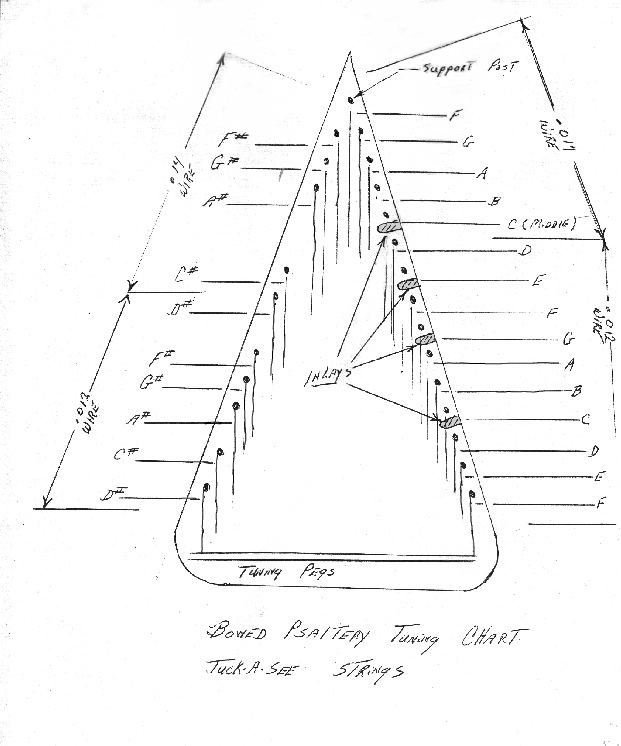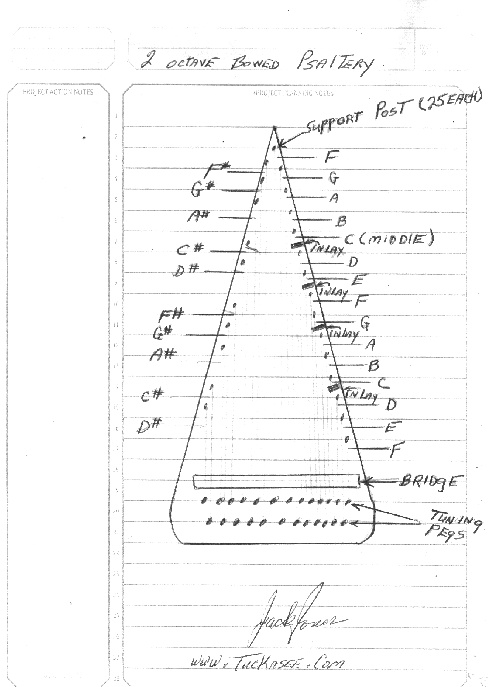
The Bowed Psaltery was one of several instruments played by King David some 3,000 years ago, and is mentioned repeatedly throughout the Book of Psalms and other Old Testament writing.
NOTE STRUCTURE:
Learning to Play the Bowed Psaltery.
First, understand the note arrangements. Think of the strings as piano
keys. On the side of the instrument where you see the four contrasting
inlays, these strings are as the white keys on a piano. (These inlays
indicate where the C Major scale is located.) On the opposite side,
the strings are as the black keys of a piano.

HOLDING THE BOWED PSALTERY
The bowed psaltery can be held in front of you with the point away from you
about waist high, with the non-bowing hand (if you are right handed, hold
the psaltery with the left hand). under the center of it allowing you
to use the bow with your strong hand. Bow the strings one at a time,
keeping the bow at an approximate 45 degree angle to the top of the bowed
psaltery.
BOWING
When playing the bowed Psaltery, hold the bow by the big end between the thumb and forefinger and allow the other three fingers to lay lightly along the side of the bow. Slide the horsehair of the bow lightly across the string with a slow steady motion. Use the full length of the bow. The action can be a push or a pulling of the bow and can be alternated to suit your style. For best sound, bow the string approximately 1/2 inch from the support post of the string.
TUNING.
Tuning the Bowed Psaltery is very easy.

The Bowed Psaltery can be tuned to a piano or other instrument. I recommend that you purchase a chromatic tuner to make tuning more accurate and easier. They are available in most music stores.
To adjust the tuning, place the tuning wrench on the tuning peg of the string you wish to tune and tighten or loosen the string to get the pitch you want.
All instruments are tuned by me before they are shipped, so it will not be hard to tune. As it gets older, it will need less tuning because the strings will stretch to a common tension.
STRING REPLACEMENT
Sooner or later a string will break. Closely examin how the strings are strung, and routed on the support post and the tuning pegs. You will see that one wire makes two strings or notes except the center string. The longest one is a single, loop end wire.
THE STRINGS ARE OF TWO SIZES
From middle C to the longest wires at the point of 0.014 inch wire. From
D next to middle C to the bridge (shorter wires) they are 0.012 inch wires.
If you wish to replace all the wires with single loop end wires, this
is fine too, your choice.
Cut the new wire about three (3) inches longer than the total distance from the tuning peg to the support post and back to the second tuning peg.
Next, put one end of the new wire in one tuning peg and turn the tuning peg 2 1/2 turns clockwise. Now thread the wire through the support posts, just like the other wires on the instrument, then put the other end of the new wire through the second tuning peg, and turn it 2 1/2 turns clockwise. Be sure to allow enough slack in the wire before turning the tuning pegs to make the 2 1/2 turns. Make sure the new wires are seated in the grooves cut into the top of the support post. Once both ends of the wire are secured into the tuning pegs and the 2 1/2 clockwise turns are made, tune the string to pitch, just as in regular tuning procedures.
NEVER TURN THE SUPPORT POST!
CARE AND CLEANING
There is not much needed in care of the instrument. Keep it dry and in a moderate temperature area. DO NOT store it under an air conditioning vent or leave it in a car on a hot day. Cleaning can be done with soft cloth, paint brush, etc. If you want to apply a light coat of furniture polish every six months, that is fine. Just treat it like any other fine piece of fine wood furniture.SUPPLIES
Replacement wires, rosin blocks, lesson books, songbooks and etc. can be purchased at most music stores that carry acoustic supplies. Example: folk or bluegrass music stores. If you would like, you can use an acoustic guitar Medium E string for string replacement. You may also wish to try www.folkcraft.com or contact me for anything you might need.Thank you for joining the family of Tuck-A-See Strings musicians. Enjoy your new Bowed Psaltery and if I can be any help, feel free to email me.
Thanks Again, Jack and Dawn Jones
